Years late and billions over budget, NASA’s new moon rocket makes its debut next week in a high-stakes test flight before astronauts get on top.
August 24, 2022
Years late and billions over budget, NASA’s new moon rocket makes its debut next week in a high-stakes test flight before astronauts get on top.
The 322-foot (98-meter) rocket will attempt to send an empty crew capsule into a far-flung lunar orbit, 50 years after NASA’s famed Apollo moonshots.
If all goes well, astronauts could strap in as soon as 2024 for a lap around the moon, with NASA aiming to land two people on the lunar surface by the end of 2025.
Liftoff is set for Monday morning from NASA’s Kennedy Space Center.
The six-week test flight is risky and could be cut short if something fails, NASA officials warn.
«We’re going to stress it and test it. We’re going make it do things that we would never do with a crew on it in order to try to make it as safe as possible,» NASA Administrator Bill Nelson told The Associated Press on Wednesday.
The retired founder of George Washington University’s space policy institute said a lot is riding on this trial run. Spiraling costs and long gaps between missions will make for a tough comeback if things go south, he noted.
«It is supposed to be the first step in a sustained program of human exploration of the moon, Mars, and beyond,» said John Logsdon. «Will the United States have the will to push forward in the face of a major malfunction?»
The price tag for this single mission: more than $4 billion. Add everything up since the program’s inception a decade ago until a 2025 lunar landing, and there’s even more sticker shock: $93 billion.
Here’s a rundown of the first flight of the Artemis program, named after Apollo’s mythological twin sister.
ROCKET POWER
The new rocket is shorter and slimmer than the Saturn V rockets that hurled 24 Apollo astronauts to the moon a half-century ago. But it’s mightier, packing 8.8 million pounds (4 million kilograms) of thrust. It’s called the Space Launch System rocket, SLS for short, but a less clunky name is under discussion, according to Nelson. Unlike the streamlined Saturn V, the new rocket has a pair of strap-on boosters refashioned from NASA’s space shuttles. The boosters will peel away after two minutes, just like the shuttle boosters did, but won’t be fished from the Atlantic for reuse. The core stage will keep firing before separating and crashing into the Pacific in pieces. Two hours after liftoff, an upper stage will send the capsule, Orion, racing toward the moon.






